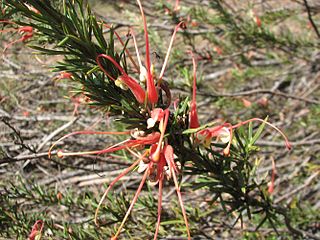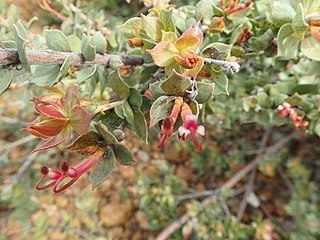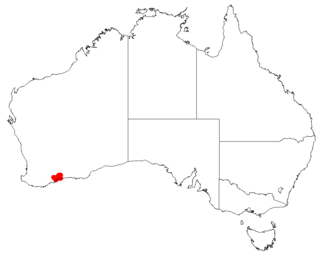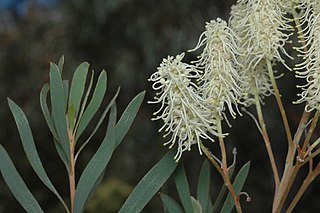
Banksia hewardiana is a species of openly branched shrub that is endemic to Western Australia. It has linear, serrated leaves with sharply pointed teeth, head of up to sixty lemon-yellow flowers and oblong follicles.

Banksia bella, commonly known as the Wongan dryandra, is a species of dense shrub that is endemic to a restricted area of Western Australia. It has narrow, deeply serrated leaves covered with white hairs on the lower surface, heads of yellow flowers and few follicles in the fruiting head.

Grevillea tetragonoloba is species of flowering plant in the family Proteaceae and is endemic to the southwest of Western Australia. It is a dense, erect to spreading shrub, usually with pinnatipartite to almost pinnatisect leaves, the end lobes linear, and clusters of yellowish-brown to fawn flowers with a scarlet to orange-red style.

Grevillea armigera, also known as prickly toothbrushes or thorny grevillea, is a species of flowering plant in the family Proteaceae and is endemic to the south-west of Western Australia. It is an erect to spreading shrub with deeply-lobed leaves, the lobes linear and sharply pointed, and grey, green or pale yellow flowers with black to maroon styles.

Grevillea obtusifolia, commonly known as obtuse leaved grevillea, is a species of flowering plant in the family Proteaceae and is endemic to the south-west of Western Australia. It is a spreading to dense, prostrate shrub with oblong to narrowly elliptic leaves and clusters of eight to twelve, pink or red flowers.

Grevillea asparagoides is a species of flowering plant in the family Proteaceae and is endemic to the south-west of Western Australia. It is dense, prickly shrub with deeply divided leaves, the end lobes linear and sharply pointed, and pink to reddish flowers with red styles.

Grevillea didymobotrya is a species of flowering plant in the family Proteaceae and is endemic to the south-west of Western Australia. It is an erect shrub with simple leaves, the size and shape depending on subspecies, and cylindrical groups of yellow or cream-coloured flowers.

Pimelea alpina, the alpine rice-flower, is a species of flowering plant in the family Thymelaeaceae and is endemic to south-eastern continental Australia. It is an erect, prostrate or spreading shrub or undershrub with narrowly elliptic leaves crowded at the ends of branches and heads of pinkish red or white flowers.

Grevillea tripartita is species of flowering plant in the family Proteaceae and is endemic to the south-west of Western Australia. It is an erect, prickly shrub with divided leaves with 3 lobes, and clusters of red and cream-coloured or reddish-orange and yellow flowers.

Adenanthos venosus is a species of flowering plant in the family Proteaceae and is endemic to a restricted part of the southwest of Western Australia. It is an openly-branched shrub with clustered egg-shaped leaves and reddish flowers.
Persoonia rudis is a species of flowering plant in the family Proteaceae and is endemic to the south-west of Western Australia. It is an erect shrub with hairy young branchlets, linear leaves, and yellow flowers borne in groups of five to thirty on a rachis 3–100 mm (0.12–3.94 in) that continues to grow after flowering.

Persoonia dillwynioides, commonly known as Fitzgerald persoonia, is a species of flowering plant in the family Proteaceae and is endemic to a restricted area in the south-west of Western Australia. It is an erect, spreading shrub with smooth bark, linear leaves and bright yellow flowers borne singly or in groups of up to four along a rachis up to 3 mm (0.12 in) long.

Persoonia trinervis is a species of flowering plant in the family Proteaceae and is endemic to the south-west of Western Australia. It is an erect, sometimes spreading shrub with densely hairy young branchlets, spatula-shaped or lance-shaped leaves with the narrower end towards the base, and densely hairy yellow flowers.

Persoonia sulcata is a plant in the family Proteaceae and is endemic to the south-west of Western Australia. It is a small, erect or low spreading shrub with narrow, linear leaves and cylindrical yellow flowers arranged singly or in groups of up to three in leaf axils. It grows in woodland or on rocky slopes and is found in several disjunct populations.
Persoonia hakeiformis is a species of flowering plant in the family Proteaceae and is endemic to the south-west of Western Australia. It is an erect or spreading to low-lying shrub with mostly smooth bark, linear leaves and bright yellow flowers borne in groups of up to sixty along a rachis up to 100 mm (3.9 in) long.
Grevillea capitellata is a species of flowering plant in the family Proteaceae and is endemic to the Illawarra region of New South Wales. It is a low, dense mounded or prostrate shrub with narrowly elliptic to oblong leaves, and dull, deep crimson to dark maroon flowers.
Grevillea pinifolia, commonly known as the pine-leaved grevillea, is a species of flowering plant in the family Proteaceae and is endemic to a restricted area in the south-west of Western Australia. It is a low, mounded shrub with linear, more or less cylindrical leaves and red to orange-red flowers.

Grevillea polybotrya is a species of flowering plant in the family Proteaceae and is endemic to the south-west of Western Australia. It is an erect, bushy shrub with egg-shaped to lance-shaped leaves with the narrower end towards the base, and usually white to cream-coloured flowers.

Petrophile carduacea is a species of flowering plant in the family Proteaceae and is endemic to southwestern Western Australia. It is a shrub with deeply toothed leaves, and more or less spherical heads of hairy yellow flowers.

Isopogon villosus is a species of flowering plant in the family Proteaceae and is endemic to southwestern Western Australia. It is a tufted shrub with cylindrical leaves with twenty-five to thirty-two widely diverging lobes, and oval heads of cream-coloured to yellow flowers.
















